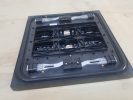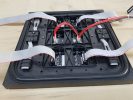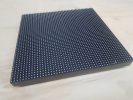There is a growing demand for larger indoor and outdoor LED displays and billboards, but there is a gap in our knowledge on where to begin when we start selling these. So to get the best tips and tricks on “How to sell a LED Display” get the ‘low down’ on the best way to approach this problem right here ….
Basic outline of Product
LED Displays are made up of individual “modules”. A module does not have any power or picture, it is just a small plastic square of LEDs that is inserted into a cabinet or frame to make up the overall “LED display”. As a general rule any module can be put in any place and they are then connected by 5 volt DC power wires (red/black) and a grey ribbon cable (data) that pulls the picture in and out (through).
A typical LED display is made up of individual power supplies that power these modules (that change the mains AC supply to a smaller 5 volt DC supply like a battery) and a special video card. The modules fit into the cabinet by a simple ‘push and turn’ mechanism from the front or the back.

Rear of a typical LED module (320mm x 320mm)

Power and data connections on a typical module
The outdoor LED modules are characterised as being brighter (6,000 nits) and waterproof. They typically have a larger gap (“pitch”) between the individual LEDs as the target market is driving past and not walking up to them. The typical pitch options are between 6-10mm. (The older ‘road works’ signs were 12-16mm).
The indoor LED modules are not as bright (800-1,500 nits) and the LEDs are usually closer together (1.8mm, 3mm and 4mm) as the target audience is right up close.
Your first choice:
Are you looking at an indoor or outdoor job (this should be fairly easy to know!).
The only small trick – if you’re doing inside a retail window, but aiming to target pedestrians outside, you may want to consider an outdoor product, not because you want the waterproof aspect, but because you want the additional brightness to beat the natural light outside.
Digital Signs does have a 3mm indoor product rated at 3,500 nits that is particularly powerful for retail use but still very cost effective (about the same cost as a commercial TV if sold by the square metre).
Your second choice:
You really just need to know the overall size your client wants.
Each manufacturer supplies the modules in different sizes. In the outdoor range 320mm x 320mm is a very common module size. This means you can have any size LED display you want, as long as it is made up in lots of 320mm (ie 320mm, 640mm, 960mm, 1280mm etc). The indoor ones are usually made into cabinets of 1000×500 (to keep the fine LEDs lined up on a cast aluminium frame).
There is no physical restriction on the width or height, the only thing to consider is the ‘aspect ratio’ (whether you want a square or a rectangle) for the graphics you are going to put on. These days a 16:9 (rectangle) aspect ratio is the most common (quite modern looking) and this can be portrait(rectangle on its short edge) or landscape (rectangle on its long edge)
About the last choice:
This would be pixel pitch, which is the gap between the LED. As a general rule, the closer the LED are together, the better the resolution of the picture, but also the higher the cost, as now there are more LED in the modules.
The way to advise on this decision is to establish where the target viewing market will mostly be. Again as a general rule a LED display becomes one uniform picture, ie you can’t tell it’s made up of individual dots. At about 1m per 1mm of pitch – ie the 3mm indoor starts to become solid in appearance at 3 metres away, and the 6mm outdoor becomes solid from about 6 metres away.
There might be a $1,000-$2,000 difference per square metre going from a 4mm to a 3mm indoor, or a 10mm down to a 6mm outdoor so assessing where your target audience will be will save your client $5,000 depending on the final screen size.
Whatever price you end up going for make sure it is quality for the price. Gold wire LED is the premium standard and the only product that should be used in 24/7 environments, but you can get copper LED that is cheaper and should only be used for rental staging or other short run jobs.
When should I use a TV?
We recommend if a TV works (usually size wise) then use a TV, ie for sales counters, end of isle and maybe window display. But the moment you are looking to join more than 2 TVs together then you want to be looking at the LED display option. The main differences between a LED display and a LED TV is the LED display will have better contrast (deeper colours and no glass reflection) and are usually rated to last around 8 years. The LED display is often brighter (at 800-1,500 nits). Most TVs are good for 3 years and have a brightness in the 350-500 nits/cdm2 range (all things being equal).
Software control
It’s all very well having your LED display up, but often your customer might ask you how the picture is controlled on it. Digital Signs own their own software to control the content on any TV or LED display. Modelled along the lines of Microsoft Powerpoint you can create any number of slides into a Playlist, then send it to any screen to start at the time you want. This software is free with each display. As a rule you want to keep away from ‘subscription’ based software as your client will be paying every month.
Being an Elite Sponsor of the NZSDA Digital Signs is extremely serious about supporting the industry and growing our relationships with sign writers as resellers. If you have any project in mind (whether it goes ahead or not) make sure you give one of our friendly team a call to start getting used to the best way to approach these jobs.
There is a very good margin in selling LED displays 😊

